Food Preservation Learning Objectives
After completing this section you should be able to:
- Describe how dehydration preserves food
- Identify foods which can easily be dehydrated and re-hydrated
- Describe temperature requirements for dehydration
- Describe the pros and cons of three drying techniques
- Properly store dehydrated foods
Describe How Dehydration Preserves Food
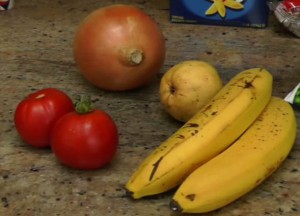 Used even in ancient civilizations, dehydration is a proven technique for preserving food. Micro organism which spoil food tend to thrive in warm, moist, air rich environments. To prevent spoilage, you need to find ways to deprive the organisms what they desire.
Used even in ancient civilizations, dehydration is a proven technique for preserving food. Micro organism which spoil food tend to thrive in warm, moist, air rich environments. To prevent spoilage, you need to find ways to deprive the organisms what they desire.
The basic concept of dehydration is simple. By removing the moisture which allows bacteria to grow you significantly extend the “shelf life” of the food. Most of us are very familiar with commercially available dehydrated foods such as dried fruit and various forms of jerky. These ready-made products, requiring no refrigeration, are ideal for on the go outdoor activities. We typically consume them in their “dried” state, and any re-hydration at all occurs within our stomach.
Although many outdoors trekkers purchase commercially freeze dried or dehydrated foods, there are also many reasons to dehydrate your own food. Doing it yourself you have complete control over the food and its quality, including using your favorite family recipes. You may also find it to be significantly cheaper, and frankly once you get into it, quite fun.
Identify Foods which can easily be Dehydrated and Re-hydrated
Most of us would probably find less than satisfactory soaking raisins in water in an effort to reconstitute grapes, or any attempts to make a nice tender piece of steak by soaking a hunk of teriyaki flavored beef jerky. You may, however, be surprised by the variety of foods which can be dehydrated and re-hydrated to excellent results.
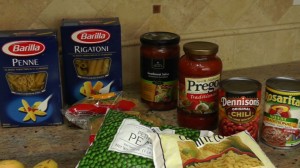
Listed are a few general categories, with typical examples in each:
- Fruits: apples, apricots, bananas, mangoes
- Vegetables: peas, corn, onions, string beans, tomatoes
- Canned foods: re-fried beans, chilli, spaghetti sauce
- Sauces: spaghetti sauce, salsa, curry sauce
- Cooked meats: ground beef, ground turkey, homemade beef jerky
- Pastas: cooked noodles, with or without sauce
You might be wondering, pasta? really? I thought it was already dried and easily carried into the field. So true. The advantage of dehydrating cooked pasta is that it will cook much faster in the field, saving both time and fuel. If you have plenty of both, continue to carry your pasta uncooked, or carry ramen which is in fact dried precooked noodles.
One category which seems to receive mixed results is eggs and some dairy. Although people do dehydrate their own, I prefer to play it safer with commercial dried eggs products.
Select the video icon to access a variety of food dehydration demonstration videos.

Describe the Temperature Requirements for Dehydration
When I first started dehydrating my own foods, a backpacking buddy was very skeptical. In fact to make his point, he asked me if I found that bowl of chili had spilled on the counter and was left to dry over night, would I eat it? Probably not I said, but I do enjoy properly dehydrated chili. The trick to dehydration is to do it in a controlled manner.
You need to ensure the drying temperature is high enough to prevent micro organisms from growing, but not so high as to lose the nutritional value or flavor of the food. Micro organisms are much more successful at spoiling your food when it is between 40F and 140F, then when it is significantly above or below. Refrigerators and freezers can keep our food well below 40, and ovens and barbeques tend to keep it well above.
There are some fairly standard safe drying air temperatures. My dehydrator has settings for:
- Nuts and Seeds: 105 F (41 C)
- Fruits: 135 F (58 C)
- Vegetables: 135 F (58 C)
- Meat: 155 F (68 C)
Note, these refer to the temperature of the air during drying, and not the temperature of the actual food.
One thing most people want to know is how long will the drying take. Drying times vary significantly depending on the size and moisture content of the food, and can also be influenced by things like the humility and air circulation during drying. Most published times have such a wide range, they are almost useless. For example:
- Apples: 135 F, 4-10 hours
- Apricots: 135 F, 8-16 hours
- Bananas 135 F, 6-12 hours
- Peas 135 F, 5-14 hours
- Tomatoes 135 F, 6-12 hours
Seriously, where else can you be that far off and still keep your job? Meteorologist? Politician? The bottom line, is that you need to monitor the process as you go. Checking and turning can help you figure it out. One thing to watch out for, is starting something that is likely to finish at say 2:30 am. You will either have to set an alarm, or let it over cook.
Describe the Pros and Cons of three Drying Techniques
Regardless of the specific technique deployed, dehydration typical requires some basic elements, a relatively undisturbed location (from bugs and animals), a heat source, with a way for moisture to escape, and time. Food dehydration may be done on trays in the sun, on sheets in a oven, or in a commercial dehydrator, specifically designed for this purpose.
Sun Drying

Sun drying is by far the cheapest way to dry food, and can be quite effective for fruits and vegetables. You simply place the food on trays, cover with a cheese cloth, and set in the sun. The down side is that you are dependent on the weather. You need to be fairly confident that air temperature will be in the 85-100 range, over several days. Evening temperature may drop significantly, meaning you will probably want to stick to safer food items, such as fruits and vegetables.
Oven Drying
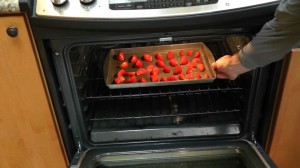
Some ovens (conventional and convection) which can operate at around 140 degrees can also be used, though the energy efficiency of heating such a large space for 6-8 hours may not be great. Also, many oven do not operate at such low temperatures and therefore you have to either over-cook the food, or leave the oven door open, making your energy efficiency even worse.
Commercial Dehydrator
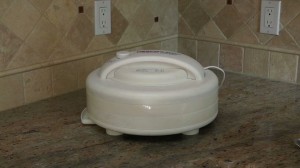
Commercial dehydrators are my preferred method for drying food. They are energy efficient and safe. Most provide stacking trays, temperature controls, and a fan for air circulation.
They trays also have feature options such as large grates to improve air circulation and drying of large items. They have mesh screens for smaller items, yet still offer circulation. For sauces and leathers, they provide lipped trays.
Properly store dehydrated foods
Once successfully dehydrated, the food is relatively stable, safe, lighter and less bulky. In other words, perfect for the wilderness.
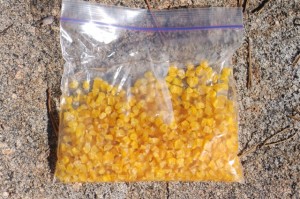
Dried food should be stored in an air tight container. I prefer to use freezer lip lock bags, which are easy to label, easy to carry, and can be used to re-hydrate the food in the field. If you have prepared your food well in advance, you may want to store it in the freezer until your trip. Dried food can be safely stored in a freezer for several months.
One tip, however, is to carry a few extra zip lock bags. Some items, when dehydrated, can acquire sharp almost glass like edges, which may actually puncture the bag, and cause leaking. Better to have a back up if needed.
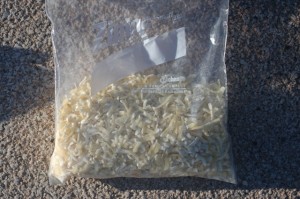

Food Preservation Review
You should now be able to:
- Describe how dehydration preserves food
- Identify foods which can easily be dehydrated and re-hydrated
- Describe temperature requirements for dehydration
- Describe the pros and cons of three drying techniques (sun, oven, commercial)
- Properly storage dehydrated foods
